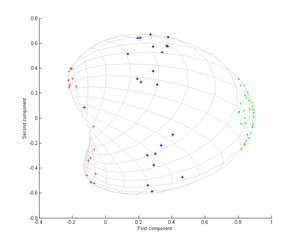Recently I added one more exciting function to DermKnowledgeBASE (DKB). Now you can search for clinical differential diagnosis for any dermatological condition by clicking here. The consult algorithm has also undergone some refinement. Thanks for all the feedback. The second read cycle is nearing completion. The sensitivity may improve as more and more data becomes available. The Colombian project is progressing well. If anybody else is using DKB webservices, few recent modifications have been made. Do let me know if you need any information. Check out the differential diagnosis for lichen sclerosus et atrophicus from DKB. BTW did anyone use the consult function recently?
| The first two principal components after PCA using a Gaussian kernel (Photo credit: Wikipedia) |
Johnson & Johnson research team has proposed a new concept to evaluate the efficacy of anti-ageing treatments and products. The concept seems to be interesting. Basically the cutaneous ageing is a combination of several measurable changes that are inter-correlated. Though the mathematics behind normalized projection on the first Principal Component Analysis (PCA) axis can be quite complicated, in essence a single value that summarises several factors is proposed as the ‘skin aging index’. They have used the method to test one of their products. I could only access the abstract.[1]
| Bee hoon (Photo credit: benoit.mortgat) |
During my series on beauty peptides, I explored the concept of collagen fragments tricking the body into producing fresh collagen. However there are other ways of stimulating collagen production and to inhibit the activity of the enzyme that breaks down collagen, MMP-1. This study suggests that Phosphatidylserine (PS) can be used as a therapeutic agent to prevent UVB-induced skin photoaging and perhaps even natural skin aging by downregulating MAPKS/AP-1 signaling pathways.[2] PS is a diet supplement commonly used by athletes to prevent muscle soreness. PS is abundant in meat, brain, liver and kidney.
References
1. Nkengne, Alex et al. “The skin aging index: a new approach for documenting anti‐aging products or procedures.” Skin Research and Technology (2013).
2. Lee, Sang‐Hoon et al. “Protective effect and mechanism of phosphatidylserine in UVB‐induced human dermal fibroblasts.” European Journal of Lipid Science and Technology (2013).

- Machine learning-based BOTOX API - April 11, 2023
- Skinmesh: Machine learning for facial analysis - November 10, 2020
- Free Dermatology EMR for Machine Learning and Artificial Intelligence - January 2, 2020





Leave a Reply